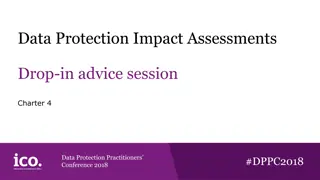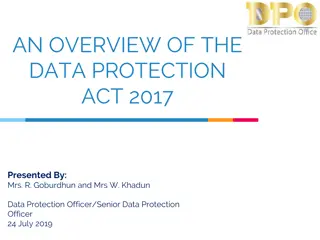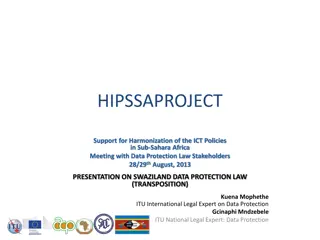Understanding Data Protection Essentials
Explore the fundamentals of data protection, including key principles, lawful processing, identifying personal data, managing breaches, and handling information rights requests. Learn about GDPR principles, special category data, and the lawful bases for processing personal information.
Download Presentation

Please find below an Image/Link to download the presentation.
The content on the website is provided AS IS for your information and personal use only. It may not be sold, licensed, or shared on other websites without obtaining consent from the author. Download presentation by click this link. If you encounter any issues during the download, it is possible that the publisher has removed the file from their server.
E N D
Presentation Transcript
AN INTRODUCTION TO DATA PROTECTION Looking for more ideas? Visit us at www.creativeeducation.co.uk
DURING THIS COURSE YOULL LEARN What counts as personal data and what do we mean by processing ? What the key principles are of good data protection How we differentiate between standard and highly sensitive or special category data When can we process personal data lawfully? When can we process special category data lawfully? When can we share data? How do we identify, report and prevent a data breach? Receiving and responding to an information rights request
PERSONAL DATA IS information that relates to an identified or identifiable living individual
PROCESSING IS Taking any action with someone s personal data. This includes recording it, keeping it, changing it, using it and deleting it.
THE 7 PRINCIPLES OF GDPR Personal Data should: Be processed lawfully, fairly and transparently Be used for a specific purpose Be relevant to that purpose Be accurate Be kept no longer than necessary Be kept securely And lastly that you should be accountable with what you do with Personal Data and how you comply with the other principles.
SPECIAL CATEGORY DATA Special Category data includes: racial or ethnic origin political opinions religious or philosophical beliefs trade-union membership genetic information biometric information (for example, a fingerprint) health matters (for example, medical information) sexual matters or sexual orientation
CONSIDER SIMILARLY a safeguarding matter pupils in receipt of pupil premium funding pupils with special educational needs and disability (SEND) children in need (CIN), and children looked after by a local authority (CLA)
THE 6 LAWFUL BASES 1. Consent 2. Contract 3. Legal Obligation 4. Vital Interests 5. Public Interest 6. Legitimate Interests
SPECIAL CATEGORY DATA Special Category data includes: racial or ethnic origin political opinions religious or philosophical beliefs trade-union membership genetic information biometric information (for example, a fingerprint) health matters (for example, medical information) sexual matters or sexual orientation
RELEVANT ADDITIONAL CONDITIONS 1. Explicit consent 2. Employment, social security or social protection 3. Vital interests 4. Manifestly made public 5. Substantial public interest
WHEN GETTING CONSENT, EXPLAIN what personal information you re sharing why you re sharing it who you re sharing it with and what they ll use it for how you ll share their information, and the process for withdrawing consent
A DATA BREACH IS Personal Data being lost or stolen destroyed without consent changed without consent, or accessed by someone without permission
KEEPING PERSONAL DATA SAFE 1. Store physical data securely 2. File documents clearly and consistently 3. Be careful working offsite 4. Send electronic documents securely 5. Don t share passwords with colleagues 6. Check before sharing your screen 7. Lock your screen when away from your desk 8. Be discrete when discussing Personal Data
INFORMATION RIGHTS To access the personal information you hold about them, which is also known as a Subject Access Request To request to change inaccurate personal information you have about them To request to remove their personal information or record To request to restrict the processing of their personal information, and To request to stop processing their personal information
THANK YOU Looking for more ideas? Visit us at www.creativeeducation.co.uk























